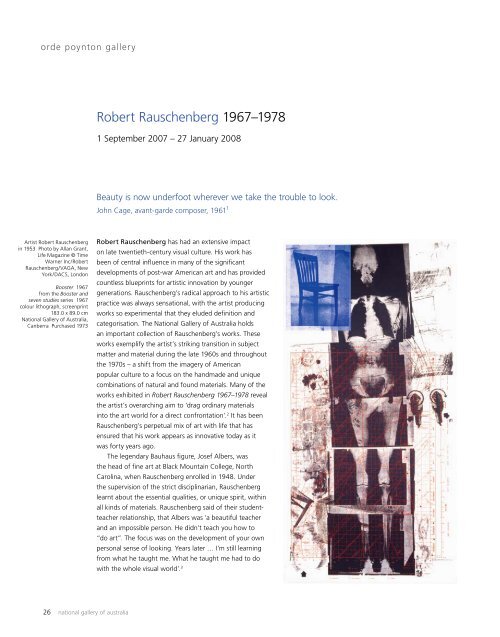Art Ew - National Gallery of Australia
Art Ew - National Gallery of Australia
Art Ew - National Gallery of Australia
You also want an ePaper? Increase the reach of your titles
YUMPU automatically turns print PDFs into web optimized ePapers that Google loves.
orde poynton gallery<br />
<strong>Art</strong>ist Robert Rauschenberg<br />
in 1953 Photo by Allan Grant,<br />
Life Magazine © Time<br />
Warner Inc/Robert<br />
Rauschenberg/VAGA, New<br />
York/DACS, London<br />
Booster 1967<br />
from the Booster and<br />
seven studies series 1967<br />
colour lithograph, screenprint<br />
183.0 x 89.0 cm<br />
<strong>National</strong> <strong>Gallery</strong> <strong>of</strong> <strong>Australia</strong>,<br />
Canberra Purchased 1973<br />
26 national gallery <strong>of</strong> australia<br />
Robert Rauschenberg 1967–1978<br />
1 September 2007 – 27 January 2008<br />
Beauty is now underfoot wherever we take the trouble to look.<br />
John Cage, avant-garde composer, 19611 Robert Rauschenberg has had an extensive impact<br />
on late twentieth-century visual culture. His work has<br />
been <strong>of</strong> central influence in many <strong>of</strong> the significant<br />
developments <strong>of</strong> post-war American art and has provided<br />
countless blueprints for artistic innovation by younger<br />
generations. Rauschenberg’s radical approach to his artistic<br />
practice was always sensational, with the artist producing<br />
works so experimental that they eluded definition and<br />
categorisation. The <strong>National</strong> <strong>Gallery</strong> <strong>of</strong> <strong>Australia</strong> holds<br />
an important collection <strong>of</strong> Rauschenberg’s works. These<br />
works exemplify the artist’s striking transition in subject<br />
matter and material during the late 1960s and throughout<br />
the 1970s – a shift from the imagery <strong>of</strong> American<br />
popular culture to a focus on the handmade and unique<br />
combinations <strong>of</strong> natural and found materials. Many <strong>of</strong> the<br />
works exhibited in Robert Rauschenberg 1967–1978 reveal<br />
the artist’s overarching aim to ‘drag ordinary materials<br />
into the art world for a direct confrontation’. 2 It has been<br />
Rauschenberg’s perpetual mix <strong>of</strong> art with life that has<br />
ensured that his work appears as innovative today as it<br />
was forty years ago.<br />
The legendary Bauhaus figure, Josef Albers, was<br />
the head <strong>of</strong> fine art at Black Mountain College, North<br />
Carolina, when Rauschenberg enrolled in 1948. Under<br />
the supervision <strong>of</strong> the strict disciplinarian, Rauschenberg<br />
learnt about the essential qualities, or unique spirit, within<br />
all kinds <strong>of</strong> materials. Rauschenberg said <strong>of</strong> their studentteacher<br />
relationship, that Albers was ‘a beautiful teacher<br />
and an impossible person. He didn’t teach you how to<br />
“do art”. The focus was on the development <strong>of</strong> your own<br />
personal sense <strong>of</strong> looking. Years later … I’m still learning<br />
from what he taught me. What he taught me had to do<br />
with the whole visual world’. 3

















